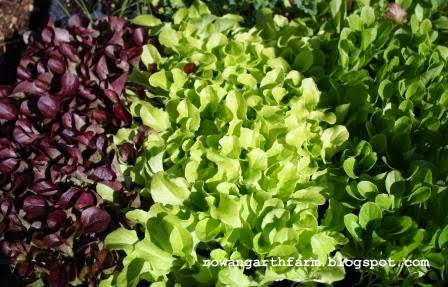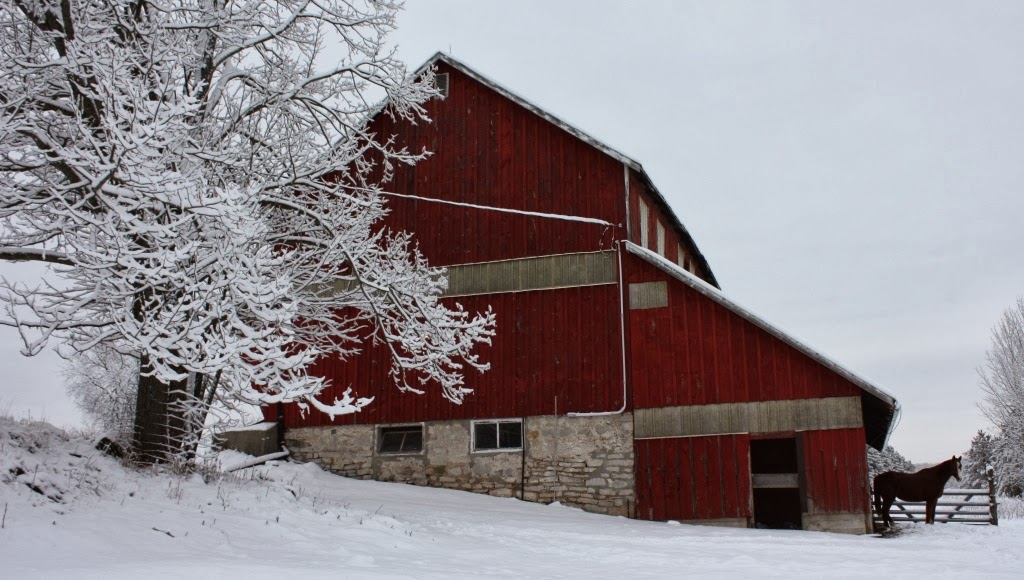Spring is a time for birth and new beginnings and I've loved reading about the many new arrivals on other farms and homesteads (see
here,
here and
here.) In fact it's inspired me to write about the time we welcomed our own new arrivals.
This is Lucy and her wee one Sammy. We
brought them to our farm in November 2008 as our wether, Oscar, was showing signs of stress due to what we thought was loneliness.

We were wrong.
Oscar was just nasty and nutty. So Oscar went (into the freezer), and Lucy and Sam stayed.
Sam thrived and grew into a fine wee buck.

Being greenhorn farmers we kept the two together too long and before we knew it he was a virile young buck. Rowangarth Farm was expecting its first babies.

I was really worried about Lucy being rebred by her own offspring, but our vet was quite pragmatic about it; the deed was done and we'd deal with the consequences.
It was hard to tell how far along Lucy was because being a pygmy goat, she resembles a barrel on four legs even when not pregnant. Knowing the gestation period is 145 to 155 days, we did the math and anticipated an August delivery. Early that month, I began looking for the signs -- a hollowing of the flank, a discharge of mucus, bagging up of her udder -- nothing.
Then one night, as I was closing up the barn, I noticed her pawing at the ground like she was making a nest. Having experienced my own nesting instincts when I was pregnant, I decided to move her to the birthing pen, next to the main goat pen, to give her some time to get used to the space.
I said goodnight and flipped off the barn light.
Around 12:30 pm that night, we awoke to the sound of whinnying and thundering hooves. Lucas and I threw on our boots, grabbed our flashlights and trundled out to the barnyard. One of the donkeys had escaped into the hayfield and the horse was flipping out. After much cajoling and carrot waving, we managed to lure her back (yes, it was Cinder... the cheeky one) and secure everyone for the night.
As I walked past the usually quiet barn, I heard Lucy cry out with a pitch and intensity that I'd never heard before. I slide open the barn door, flicked on the light -- and there was Lucy with her three newborn babies: two boys and a girl, two white like dad, and one fawn like mum. They were perfect.

The afterbirth was still hanging from her and the kids were still wet from their watery delivery. I grabbed the birthing kit and pulled from it a pile of flannel receiving blankets that I once wrapped my own babies in.
I helped rub down the tiny kids and dabbed their umbilical cords with iodine. I put down some fresh straw for bedding and gave Lucy a bucket of warm water with a cup of cider vinegar and a handful of raisins for a treat.
Then I sat quietly in the pen, simply watching and reveling in the beauty and wonder of new life. Lucy was an attentive mama and she encouraged all of her babies to suckle, chortling and nickering as she nudged them towards her udder.

One baby was smaller than the others (the white one pictured above), and he couldn't get up off his belly. I'd read about how many farmers who don't want to bother raising buck kids for meat simply drown them at birth. It made economical sense, but I simply couldn't do it. It was the first time I came face-to-face with the realities of rearing livestock; it made me question whether I would ever have the fortitude to make a living doing this or whether the animals will remain a project of my heart. I'm still wrestling with the answer.
I moved slowing and carefully and positioned myself beside the new mama. Her udder was bright pink, silky and warm. I gingerly took a tiny teat in one hand an and sterile shallow cup in the other and I slowly began to draw some of the thick, sticky colostrum from her. I'd read about offering this first milk to kids in a pan, but baby showed no interest at all in feeding. I'd also read about using a stomach tube, but I didn't have one on hand and as it was now 2 a.m., it would be several hours before we could make it to the farm supply store.
What we did have was a large supply of newborn syringes for human babies. I knew there was a danger of discharging nourishment into the kid's lungs and not the stomach, but I felt if I did nothing, he'd certainly die.
So I took the wee runt in my lap, pried open his mouth and gave him his first drops of sustenance. He dribbled some of it on his chin, but I was sure most of it made its way to his tiny belly.
I remember laughing at Sam who kept popping up and looking over at his new brood/siblings. It looks like he's smiling in this photo, doesn't it?

I didn't stay in the pen too long as I didn't want to interrupt this new family's precious bonding time. I tucked the runt back in with mama, closed the pen gate and for the second time that evening, flicked off the barn light.
I dozed for a few hours but by 6:00 a.m., I was headed back out to the barn. I remember feeling nervous -- would I find happiness or heartache?
You be the judge.

We continued to supplement the runt's nursing with a syringe for the next few days but I left most of the mothering to mama.

As Lucy was raising three babies, we didn't think there wasn't much milk left for us. We could have bottle fed all three of them, which would have been the sensible thing to do given that we were interested in using goat's milk, but we didn't.
I was in such awe of Lucy's mothering and the growth and development of her babies, I let nature take its course. She did a beautiful job raising her spirited little ones.

This is the whole family in April 2010 when the kids are 8 months old. We named them Rosie, Billy Nibbles and Archie -- he's the runt, who's grown into the biggest 'kid' of the three.

Sadly, we lost Billy Nibbles this past fall to urolithiasis, a condition whereby urinary calculi form in the urinary tract making it impossible to pee.

While I look forward to welcoming some spring arrivals to our farm again, we don't plan on breeding the girls any time soon. While I'm still interested in milking goats, it's not part of this year's plan. Besides, we may want to consider Nigerian or perhaps Nubian goats, both being higher milk producers than pygmies.
In the meantime, I tell people these are my starter 'herd', to help me learn about the ins and outs of raising goats. Truth be told, they are more pets than livestock now. But they keep the weeds down, the sumac in check and they show us all the weak spots in our fencing. They're also an endless source of
amusement and joy and I feel privileged to have shared in their beautiful and wondrous beginnings.
 I finished that baby cardigan, sort of. I cast off the main body but simply couldn't get myself excited about knitting the arms or collar. (I think it makes a pretty cute vest anyway and it still counts as this month's Year in Colour project, right?)
I finished that baby cardigan, sort of. I cast off the main body but simply couldn't get myself excited about knitting the arms or collar. (I think it makes a pretty cute vest anyway and it still counts as this month's Year in Colour project, right?)



















































